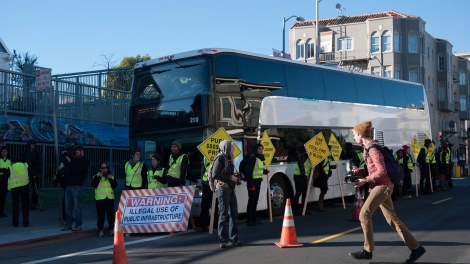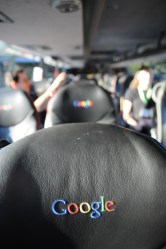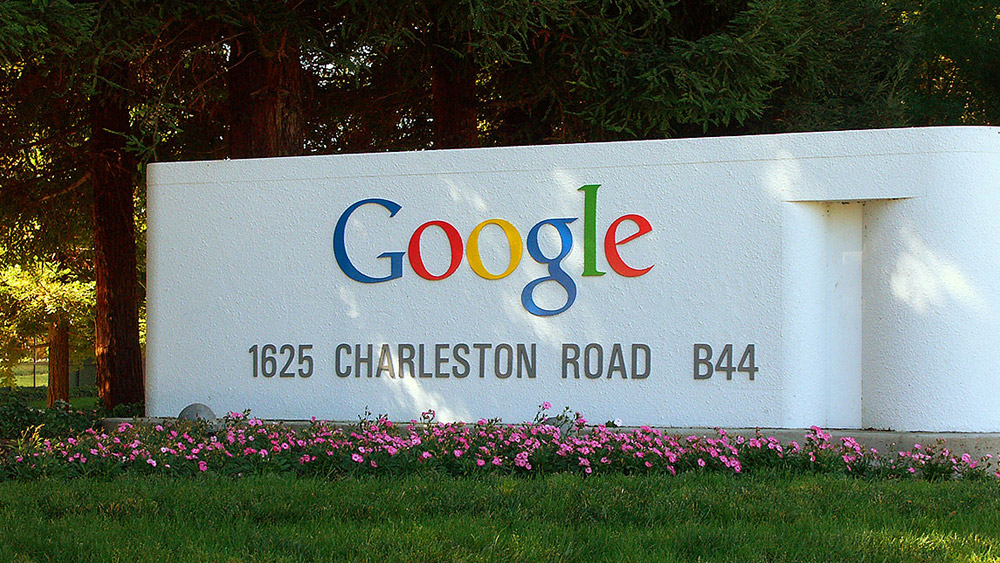
cjmartinA Google bus surrounded by protesters.
If you hear the words “luxury travel,” what comes to your mind? A private jet, perhaps? A massive, gas-guzzling SUV, like a Lincoln Navigator? A chauffeured limo? Whatever it is, I bet it’s not a bus.
And yet, remarkably enough, that humble, shared mode of transportation has become a locus of class antagonism. To add further to the irony, the people complaining about the buses — private buses that take employees of tech companies to suburban campuses — are the residents of San Francisco, an unusually rich city. The techies are said to be destroying the city with their lame, materialistic ways. And it’s all the fault of the buses rented by their employers.
The beef has been brewing all year. In February, San Francisco writer Rebecca Solnit published a widely read takedown of Google in the London Review of Books, complaining that the company is ruining her city by bringing hordes of “white or Asian male nerds” who can afford high rents. The piece opens with several paragraphs of contemptuous description of the buses, and concludes by arguing that “the Google Bus just seems like one face of Janus-headed capitalism; it contains the people too valuable even to use public transport or drive themselves.”
At San Francisco’s annual Pride Parade in June, anti-eviction protesters rented a bus similar to the ones Google uses and affixed a sign in Google font reading, “GET OUT: Gentrification & Eviction Technologies.” San Francisco drag band Persia made a song called “Google Google Apps Apps” complaining that techies are gentrifying the Mission District.
Earlier this month, things really got heated. Protesters blocked a Google employee commuter bus in the Mission for half an hour. As the San Francisco Chronicle noted, “The buses have, for some, become a symbol of tech-fueled gentrification, economic inequality and soaring housing prices in the city.” A labor organizer pretended to be an obnoxious Google employee shouting, “This is a city for the right people who can afford it.” A video of the stunt went viral before it was debunked. Then, on Dec. 20, an Apple bus was blocked in San Francisco and a Google bus in Oakland was not only blocked but had a window smashed and its tires slashed.
Does this antagonism for private employee buses — which are used by Apple and Facebook as well as Google — make any sense? Not from an environmental standpoint.
The protesters do have some legitimate grievances. Normally, when you talk about businesses full of uncool rich people destroying the character of a liberal, artsy city, such as the finance industry in New York, the offices are located in town. Some employees commute in from the suburbs and spend some of their money and pay some sales taxes in the city. Others live there and spend almost all income there. If an increasing number of the highly paid employees follow artists and creative professionals into previously diverse neighborhoods, it can cause displacement and economic hardship for the lower-income residents. But the city enjoys a lot of economic benefits as well.
The tech industry in Northern California has bizarrely inverted the norm. Most big tech company offices are on sprawling suburban campuses, while many of their employees desire the cultural amenities of a city. So the techies bring their high incomes to San Francisco, but spend most of their time outside the city — and their employers pay all of their property taxes outside the city. San Francisco gets the increased rents and cultural conformity, but misses out on many of the advantages of being home to a successful industry.
On the other hand, these firms have made the whole Bay Area a center for the technology industry. Newer tech firms, recognizing that their employees want an urban experience, are often locating in San Francisco proper. (Critics note, though, that Twitter and other such companies got hefty tax breaks for locating in San Francisco and that they mostly hire outsiders who relocate to the city, not prior residents.)
Meanwhile, gentrification in San Francisco is on steroids, thanks in part to a California state law called the Ellis Act, which allows tenant evictions if a landlord is getting out of the rental business. Activists say it is often abused. Evictions in San Francisco are concentrated in gentrifying neighborhoods, according to data compiled by the Anti-Eviction Mapping Project. Rents are soaring. The San Jose Mercury News reported Sunday, “The average rent in San Francisco shot up 11.9 percent — to $3,096 per month — in the third quarter of this year from the same period last year. In Oakland, the average rental price is $2,124, up 10.3 percent from last year.”
The dislocation and inequality are real, and the questions about the city’s priorities are valid. Activists complain that tech company buses block bicycle lanes and get in the way of public buses, causing bike accidents and delays in public bus service. The private buses have been using public transit stops without getting permission or proffering any payment. If you did that with your car, you could get fined $271, but the city government has not been assessing fines on the private companies. (It is currently working out a deal with the companies to issue and charge for permits for the buses to use the stops.)
“The private buses are really not integrated into city planning,” says Erin McElroy of Eviction Free San Francisco, which organized the two recent bus blockages in San Francisco and the June Pride Parade action. “We’re also seeing rents have gone up 20 percent in the last year along tech bus routes, because [tech company employees] move to units near those stops. Eviction rates also go up along tech bus routes because of speculation [by landlords].”
Nonetheless, McElroy’s desire that the buses be shut down altogether, and Solnit’s broadsides against them, are letting the perfect be the enemy of the good. The majority of commuters in the Bay Area travel by private automobile, and there is plenty of traffic to show for it. Solnit’s complaint that Google thinks its employees are too important to “drive themselves” is backward and nonsensical. Driving in one’s own private car is far more elitist than sharing a bus with one’s coworkers. It is also vastly worse for the environment. The buses take cars off the road. Fewer cars mean less traffic, and less idling in traffic, which is especially polluting.

Thomas BonteInside a Google bus.
The Bay Area Council, the local business lobby, estimates that without the shuttles tech workers would take an additional 327,000 car trips every year, logging 20 million extra miles and spewing 10,000 tons of CO2.
The buses’ critics contend that if they did not exist, there would be a stronger constituency for improved mass transit service. Maybe. The problem with suburbia is that it is so spread out that you often cannot walk from the downtown train station to your final destination. McElroy suggests that the companies could offer shuttle service from the suburban commuter train stations to the campuses. It’s a good idea, but it still means a three-leg journey: from one’s home to one of the few Caltrain stations in San Francisco, a train to Mountain View, and a shuttle from the train to the office. When faced with multiple connections, people tend to simply drive door-to-door.
One potential outcome of eliminating the tech buses, which the San Francisco hipsters would love, would be for the tech employees to decide to live nearer to their offices in the suburbs. But the San Francisco government isn’t going to root for that outcome. No city is going to spurn rich people who want to move there.
The question for residents fearful of displacement, then, is what they should demand. Changes to the Ellis Act, which enables evictions, is one component of an anti-displacement strategy, and activists are already working on that.
What the Bay Area really needs, though, is zoning reform. San Francisco and Oakland are fully built out at low densities. San Francisco is often compared to Manhattan — similarly rich in money and culture — but it is one-quarter as dense. It is only half as dense as Brooklyn. To house more people, which is what San Francisco must do to accommodate the new tech workers and the lower-income immigrant families and artists who live there now, it must build upward. Instead, as Matthew Yglesias observes in Slate, it keeps permissible building heights inexplicably low, even along transit corridors.
San Francisco should also consider raising taxes on its wealthy new residents to support programs to build public housing and to subsidize rents for low-income families. The environment will only benefit from gentrification if we expand the supply of housing — both market-rate and affordable — to allow inner-city populations to grow.
Getting rid of the tech company buses is neither wise nor realistic. As even McElroy admits, “It’s not like the buses themselves are causing evictions.” They are just a symbol, and a badly chosen one.
—–
[CORRECTION: This post originally called for raising income taxes in San Francisco, but in fact California law prohibits cities from levying income taxes. The city could raise other taxes, though, and make them progressive.]



